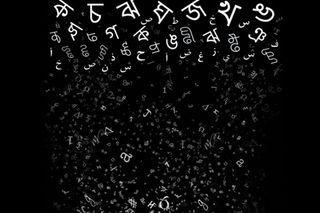
From ‘Cunt’ to ‘Careerwoman’: the Many Ways in Which Language Propagates Sexism
Think before you speak.

Fact 1: The word in colloquial Hindi for having sex is “chodna” (to fuck), which is also the suffix to India’s favorite profanities — “bhenchod” (sister-fucker) and “madarchod” (mother-fucker). While the infinitive form implies consensual sex, the abuses imply sex where the woman has no agency. In purer forms of the language, there are different words for rape (“balatkar“) and sex (“Yaun Kriya“), but they don’t exist in everyday conversational usage.
Fact 2: In India, where a greater part of the population speaks Hindi, understanding of consent remains abysmal and a woman continues to get raped every 13 minutes.
While one should be cautious in drawing direct causation between language and people’s behavior in society, there is a correlation between Fact 1 and 2 — between language and performance of gender — that needs to be examined urgently. To simply look at the semantics of language and entirely ignore the social context of it is to assume that languages evolve in cultural vacuums. But languages are a product of society. There is a whole branch of linguistics — socio-linguistics — that looks at how caste, class, gender, race, etc., affect language, and how language, in turn, socializes its speakers through encoded power structures.
There are several ways in which sexism, especially, is encoded in our languages as a conscious method to oppress and control women, and as a consequence of existing pejorative attitudes toward women. Being aware and wary of their many manifestations is crucial if we want to reappropriate languages in an egalitarian way.
Everyday examples of gendered language
False gender-neutrality is one of the ways in which language is gendered. Even though the words “he” and “man” are gender-specific, they are used to classify all people, even women, whereas “she” and “woman” remain specific to the female identity. Neil Armstrong’s “One leap for man, one giant leap for mankind” has, in a way, forever excluded women from the first big space milestone humanity achieved collectively. “Mankind,” “manmade,” and “early man” are terms with encoded gender ideologies that have historically sidelined or dismissed women.
If a woman falls off a ship, you’ll hear “man overboard; if she’s killed, its “manslaughter;” if she needs to buck up, she’s asked to “man up” and “grow a pair [of testicles].” This false gender-neutrality is not limited only to English. The Hindi word for a male is “purushya” derived from Sanskrit’s “purush,” which actually means “human.” Similarly, the words, “insaan” (human) and “aadmi” (man) are colloquially interchangeable to mean both. These generic masculine pronouns contribute to making women’s existence invisible, concludes one University of Illinois paper published in The American Journal of Psychology, by “[reducing] the likelihood of thoughts of females in what are intended to be non–sex-specific instances.”
Related on The Swaddle:
All The Arguments You Need: To Convince Doubters of Feminism
Languages also have encoded in them maleness as the norm. Consider the terms “career woman,” “lady doctor,” “female athlete,” and the like. These do the opposite of making women invisible; they highlight the presence of women, making it clear their participation in these fields is not default, but something out of the ordinary. The premise is that maleness is the norm (have you ever heard of “career man”?) and that women doing these jobs are exceptions. When words such as “doctor,” “engineer,” or “lawyer” are used, they’re accompanied by masculine personal pronouns, while words like “housekeeper,” “nurse,” and “babysitter” are seen with feminine personal pronouns. Oxford dictionary’s example sentences demonstrate this: consider “He is a registered professional engineer in New Hampshire” as opposed to “As a registered psychiatric nurse, she spent years caring for gay kids.” Even though the words “poet” and “authors” are gender-neutral, it is so anomalous to the norm of men historically dominating the literary world, that society synthesized a trivializing “poetess” and “authoress” to identify the gender of the artist.
This asymmetry in vocabulary is a clear linguistic reflection of deeply-ingrained sexism. In 2018, Baba Ramdev created controversy when he started selling medicine for infertility by the name of “putrajeevak beej” (son-bearing seeds). In India, on average, there were 2,332 cases of female feticide daily between 2000 and 2014 and the mortality rate of girls under the age of five is 75% higher than that of boys (due to systemic female infanticide before they turn two or gendered neglect of the girl child by her guardians until the age of five). Such gendered language, then, not only reflects the social reality of the country but also runs the danger of making it worse by stressing on the birth of the male child.
Most languages, including English, need “sex marking,” as termed by Marilyn Frye in 1983 (before the distinction between sex and gender had been emphasized within the social sciences) — that is, one needs to know the sex of a person to know with which pronouns to refer to them. This is a symptom of a general tendency to make sex relevant where it doesn’t have to be. The same faulty logic applies to titles: Mr. John remains Mr. John throughout the man’s life, but Ms. Sheila becomes Mrs. Sheila as soon as she becomes a wife. Fyre additionally suggests that the constant need to know the sex (and marital status) of the other person perpetuates the idea that the sex of a person is crucial in all walks of life. For her, this is a key way in which language is used to perpetuate male dominance: by emphatically and tirelessly asserting the difference between men and women.
Of course, Fyre, much like her contemporary feminists from the 1980s, did not have transgender issues in mind and even ascribed to the theory that sex and gender are the same. As the feminist movement expands to become more inclusive, the norms of “sex marking” are also changing. For instance, it is considered progressive and polite to explicitly mention your preferences for pronouns now based on your place on the gender spectrum. It is also interesting to see how third genders are navigating male-female dichotomiesin language, further contesting embedded patriarchal encodings. Trans people are increasingly being referred to by “they” in English. Curiously, a study found the hijras of Banaras tend to use feminine forms of Hindi for hijras considered social equals, and masculine forms are used for hijras of either higher or lower status.
Related on The Swaddle:
Transgender Kids’ Brains Reflect Their Gender Identity in Structure and Function
The male world-view is encoded in our language, either by the use of terms that depict a reality that is more natural to men than women or by reinforcing stereotypes assigned historically by men to oppress women. In “Feminist Philosophy of Language,” Jennifer Saul and Esa Diaz-Leon say: “‘Sex’ is generally taken to refer to an act that is defined in terms of male orgasm, while the sexual activities during which many women have their orgasms are relegated to secondary status, referred to by terms like ‘foreplay.’ These terms, then, can be seen as based on a male perspective on sex…. As a result, these terms may serve as a barrier to accurate communication … about women’s experiences of sex.” In another paper, Catharine MacKinnon in her book, Towards a Feminist Theory of State, discusses the legal definitions of ‘rape’ as involving more than “the normal level of force” on the survivor, stemming from the idea that some level of force is acceptable in sexual relationships. The absence of some words also points to how language encodes a male worldview. Until very recently, women did not have a word to describe a string of recurring experiences until feminists came to the rescue and coined “sexual harassment.” Only when the word existed, did it became easier to talk about and fight against it.
Phrases like “crying like a little bitch,” “running/fighting like a girl,” “mehendi laga ke baithna” (having wet henna on your hands) and “chudiyan pehn ke baithna” (wearing bangles on your wrist) all signify that women are the weaker sex — sexism’s core principal. Other words such as “catfight” (‘cat’ evolved as a contemptuous slang for promiscuous women) and the Serbian word for a woman’s mother-in-law, “svekrva,” (which translates to ‘one at fault for everything’) propagate the idea that interpersonal relationships between women are toxic and irrational. Even words that somehow were neutral (or favorable to women) at their inception, have been refashioned with a sexist world-view, and their original meaning, all but lost. “Mistress” earlier meant a woman with authority; it now means a woman, other than a man’s wife, who has long-term sexual relations with him. “Hussy” meant the female head of a household; now it refers to a disreputable woman. “Madam,” which used to denote a woman of high rank, is used today for a female manager of a brothel.
Then there is the most violent, obvious forms of gendered language: “motherfucker” and “sisterfucker,” which are used to refer to someone who fucks their own sister/mother and thereby is a social outcast. It is also used as a threat to the receiver of the abuse that their sister/mother shall be fucked by the abuser. Either way, the words imply thatwomen exist only to satisfy men’s anger/lust/playfulness. No parallel words for brothers and fathers exist. Sons are invoked, but only to be mocked for being a “son of a bitch.” There’s a slew of pejorative words like “bitch” (female dog), “cunt” (female genitalia), sissy (from the benign word ‘sister’), and “pussy” (slang for, again, female genitalia) that negatively correlates the feminine with weakness and stupidity.
Hindi has similar gendered patterns. “Maa ki aankh” which is a — believe it or not — euphemistic way of saying “Maa ka bhosda,” both translating to “mother’s vulva;” “chutiya” is used to refer to someone cowardly or lame but literally translates to “vagina;” and, transphobia creeps in with “behen ke lode” (sister’s penis). And in Tamil, for instance, “kena punda,” an abuse for women, translates to “loose vagina,” as in, belonging to a woman who has been penetrated a lot. Colloquialisms such as Hindi’s “gaand phaadna” (tearing the vagina), Italian’s “incazzarsi” (getting dicked), and English’s “fucking someone up” — all have the same meaning of getting livid to the extent of verbal and/or physical consequences and all call upon themes of sexual violence and rape of women. Speaking of rape, sexist humor is another way language uses levity to allow for the expression of prejudice against women.
How does gendered language affect reality?
The father of modern linguistics, Ferdinand de Saussure, saw language as a type of social behavior that links thought and sound, which resonated with sociological thinking of the early 20th century. His contemporaries Emile Durkheim and Marcel Mauss further extrapolated on this social behavior by giving ‘linguistic culture’ the same amount of important as historic and scientific cultures have in the making of society. This idea that our environment is created by linguistic, scientific and historic cultures — also known as the “social construction of reality” — has now been expanded to the “linguistic construction of social reality.” This implies that we not only need language to be able to perceive and respond to various other kinds of cultures but also to society as a whole. It, then, becomes not so much about language affecting what we think about, but how we think about reality by breaking it down into categories and labeling them.
The Sapir-Whorf linguistic hypothesis is the most contemporary and straightforward of these sociolinguistic theories. It posits that an individual’s thoughts and actions are somewhat determined by the language or languages that the individual speaks: “It is quite an illusion to imagine that one adjusts to reality essentially without the use of language and that language is merely an incidental means of solving specific problems of communication or reflection. The fact of the matter is that the ‘real world’ is to a large extent unconsciously built upon the language habits of the group.”
The choice
But what comes first, language or prejudice? Does gendered language mirror our cultural assumptions and biases about gender or do we shape our biases and behaviors based on the vocabulary we have? Firstly, it doesn’t matter outside of rhetoric — the chicken-and-egg-situation was created as an unsolvable philosophical paradox. Secondly, think of it as money. The way you can convert money into anything and everything can be turned back into money; so can language absorb social ideas and replug them, mirroring back social reality, as is. If sexist thoughts are an abstraction of the social, communicated via language, then society is a coalescing of sexist thoughts. By logical extension, these sexist thoughts can be replaced with feminist ones to not only break the vicious cycle but replace it with a more egalitarian one. And every time you choose to communicate using a language, you also have the choice between the two ideologies you further. No pressure.
Pallavi Prasad is The Swaddle's Features Editor. When she isn't fighting for gender justice and being righteous, you can find her dabbling in street and sports photography, reading philosophy, drowning in green tea, and procrastinating on doing the dishes.
Related


Women Report Surprise Choking During Sex and It’s Scaring Them
